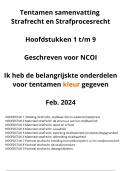Summary
Book Summary - Doing a Literature Review in Health and Social Care: A practical guide
- Course
- Institution
- Book
Here is a summary of the book "Doing a Literature Review in Health and Social Care: A practical guide" by Helen Aveyard. The book is 175 pages but this summary is only 44 pages! ** All the best points of this super useful guide to every section of writing a paper, including: How to write the perfec...
[Show more]













